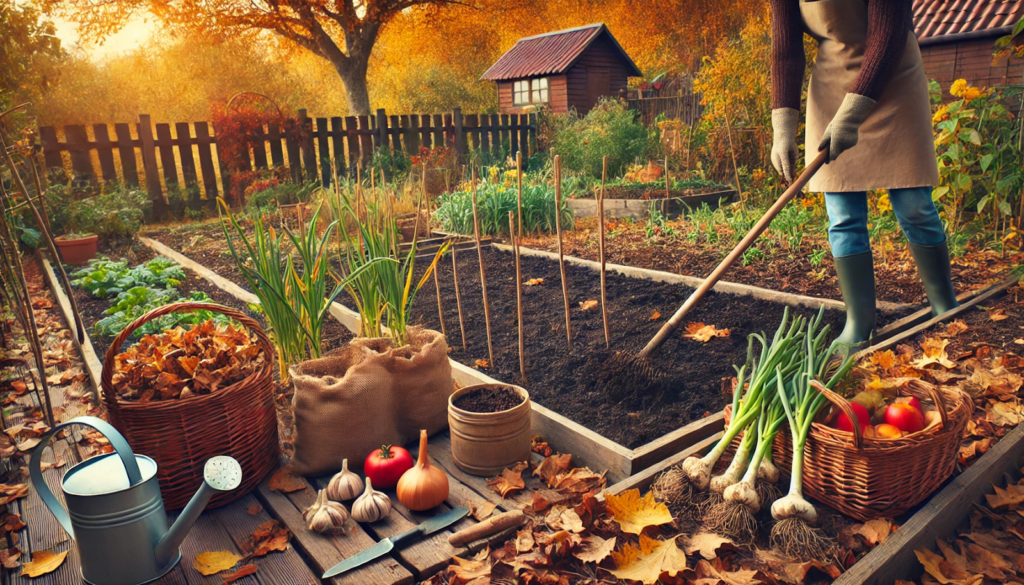As the growing season winds down, many gardeners make the mistake of stepping away from the garden entirely. But fall is one of the most important times to invest in your soil, clean up your space, and lay the foundation for better results in the spring.
In this guide, you’ll learn how to make the most of autumn by preparing your garden for the next growing season—from soil building to strategic planting and winter protection.
1. Clean Up Spent Plants and Debris
The first step in fall garden prep is to remove anything that won’t benefit your soil or next year’s crops.
What to Remove:
- Dead annuals and vegetable plants
- Diseased or pest-infested plants (do not compost)
- Weeds and invasive plants
- Fallen fruit or vegetables
Removing debris reduces the risk of pests and diseases overwintering in your garden.
2. Add Organic Matter to Enrich Soil
Fall is the best time to feed your soil. Organic matter added now will decompose over winter and be ready by spring.
Best Soil Amendments:
- Aged compost
- Well-rotted manure
- Shredded leaves
- Cover crops (see below)
Spread 1–3 inches of compost over your beds and gently work it into the top layer. You can also let it sit on top as a “blanket” until spring.
3. Plant Garlic and Other Fall Crops
Some crops actually prefer to be planted in the fall for a spring harvest.
Best Fall Plantings:
- Garlic: Plant individual cloves in well-drained soil 2–4 weeks before the ground freezes.
- Shallots and onions: Select hardy varieties for fall sowing.
- Spinach, kale, and arugula: In mild climates, these can be direct sown in early fall.
- Cover crops: Plant legumes or grasses to enrich the soil and prevent erosion.
4. Mulch and Protect Garden Beds
Mulching is essential in fall to protect soil and plant roots through winter.
Benefits of Fall Mulching:
- Regulates soil temperature
- Suppresses winter weeds
- Prevents erosion from rain and wind
- Feeds the soil as mulch breaks down
Apply 2–4 inches of organic mulch like straw, shredded leaves, or bark chips.
5. Prune Carefully (Or Not at All)
Fall isn’t always the best time to prune—but in some cases, light pruning is helpful.
What to Prune:
- Dead or damaged branches from shrubs and trees
- Spent flowering stalks from herbaceous perennials (optional)
Avoid Pruning:
- Spring-blooming shrubs (like lilac or forsythia)—you’ll cut off next year’s flowers
- Evergreen trees and shrubs
- Most fruit trees (better pruned during winter dormancy)
6. Build or Refresh Compost Piles
Take advantage of all those fallen leaves and garden clippings by building a new compost pile or expanding an existing one.
Fall Compost Ingredients:
- Green material: Grass clippings, veggie scraps, garden trimmings
- Brown material: Dry leaves, cardboard, paper, straw
Alternate layers of green and brown material and keep the pile moist. Turn regularly if temperatures allow.
7. Plant Cover Crops to Build Soil Naturally
Cover crops (also known as green manure) are planted to protect and improve soil during the off-season.
Great Fall Cover Crops:
- Clover
- Rye
- Vetch
- Winter peas
These crops suppress weeds, fix nitrogen, and improve soil texture. In spring, you can cut and till them into the soil before planting.
8. Divide and Transplant Perennials
Fall is the perfect time to divide crowded perennials and relocate plants that need more space or better growing conditions.
Plants That Respond Well to Fall Division:
- Hostas
- Daylilies
- Coneflowers
- Peonies (early fall)
Water transplants thoroughly and apply mulch to insulate them over winter.
9. Protect Perennials and Sensitive Plants
Give your plants a better chance of surviving harsh weather with a few protective steps.
How to Protect:
- Add a layer of mulch around root zones
- Use burlap or frost cloth on tender shrubs
- Move potted plants to sheltered areas like patios or garages
Remove protection in early spring when the risk of frost is gone.
10. Clean and Store Tools and Supplies
Before winter sets in, take time to maintain your tools and equipment.
To-Do List:
- Wash and dry all tools
- Sharpen blades and oil metal parts
- Drain and store hoses indoors
- Clean seed trays and pots
- Store fertilizers, sprays, and soil amendments in a dry, cool place
Organizing your tools now makes spring gardening much smoother.
Bonus: Plan Ahead for Spring
Use this quieter season to review what worked and what didn’t in your garden.
Ideas:
- Sketch out next year’s layout
- Research new plants or varieties
- Order seed catalogs
- Start a garden journal
Conclusion: Autumn Is the Season of Preparation
Fall gardening is about more than wrapping things up—it’s about laying the groundwork for a successful and abundant spring. By investing time now to clean, enrich, and organize, you’ll be rewarded with healthier soil, stronger plants, and less work when the new season arrives.
Don’t let your garden go dormant without a plan. Use the fall to build the future of your growing space.






